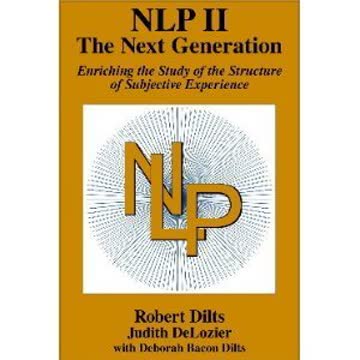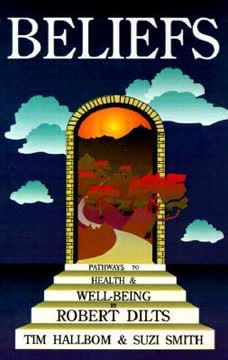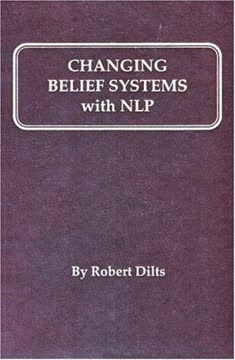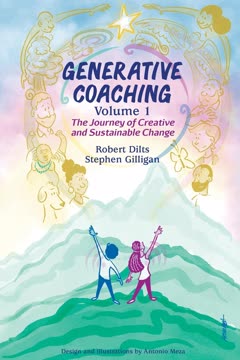Key Takeaways
1. Next Generation NLP Integrates Three Minds
Third generation NLP expands to include both somatic processes and larger system dynamics (i.e. “field”) in the total “unit of mind.”
Evolving NLP. Neuro-Linguistic Programming (NLP) has evolved through generations, moving beyond its initial focus on individual cognitive processes. First-generation NLP, developed in the 1970s, concentrated on problem-solving at the behavioral and capability levels, primarily within the cognitive mind. Second-generation NLP, emerging in the mid-1980s, broadened its scope to include beliefs, values, and meta-programs, emphasizing self-to-other relationships.
Three intelligences. The defining characteristic of Third Generation NLP is its integration of three distinct "minds" or intelligences, creating a more holistic approach to human potential and change. This expansion acknowledges that our mental functioning is not solely confined to the brain. These three minds are:
- Cognitive Mind: Emerges from the brain, responsible for intellect, reason, language, and conscious thought.
- Somatic Mind: Centered in the body, representing our foundational, intuitive intelligence.
- Field Mind: Arises from our connection and relationships with larger systems, encompassing collective intelligence and purpose.
Holistic intelligence. The aim of Third Generation NLP is to develop and sustain an organic relationship of balance and alignment between these three minds. This integration leads to a deeper, more multidimensional intelligence, enabling generative, systemic change focused on identity, vision, and mission, applicable to individuals, teams, and even organizational cultures.
2. The Cognitive Mind: Structuring Subjective Experience
Bandler and Grinder defined Neuro-Linguistic Programming as the study of the structure of subjective experience.
Foundational insights. The cognitive mind, residing primarily in the brain, was the initial focus of NLP. It encompasses intellectual abilities, reason, and processes like attention, memory, problem-solving, and language. Early NLP explored how our nervous system ("neuro") and language structures ("linguistic") create patterns ("programming") that influence behavior, both effective and ineffective.
Key cognitive tools. Significant developments in understanding the cognitive mind include:
- Time Perception: How we subjectively represent past, present, and future (e.g., "in time" vs. "through time" time lines).
- Perceptual Positions: Shifting perspectives (1st-self, 2nd-other, 3rd-observer, 4th-system) to enhance communication and wisdom.
- Neuro-Logical Levels: A hierarchy of influence (environment, behavior, capabilities, beliefs/values, identity, spiritual) that organizes information and change.
- S.C.O.R.E. Model: A framework for defining problems and solutions (Symptoms, Causes, Outcomes, Resources, Effects).
- Meta Program Patterns: General thinking styles that filter and direct our attention (e.g., "move toward" vs. "move away").
Unified framework. These distinctions, along with sensory representational systems and accessing cues, form the "Unified Field Theory for NLP," providing a comprehensive framework for understanding how all NLP techniques fit together. This framework, often visualized as a "Jungle Gym" or "apartment building," allows for precise mapping and intervention within the problem space of human experience.
3. The Somatic Mind: Unlocking Body's Innate Wisdom
Soma is the Greek word for “body.” The somatic mind is the mind within your body. Our somatic intelligence is our foundational intelligence.
Body's intelligence. The somatic mind represents the body's inherent intelligence, a foundational form of knowing that predates and underpins cognitive thought. It's accessed through a "felt sense"—a bodily awareness of ongoing life processes, distinct from emotions, offering precise and intricate somatic thinking. This intelligence is crucial for survival and effective interaction with our environment, anchoring our awareness in the present moment.
Multiple brains. Modern neuroscience reveals that the body hosts multiple "brains" beyond the skull:
- Enteric Brain (Belly): A complex nervous system in the gut with 100 million neurons, managing digestion and influencing emotions ("gut feelings"). Traditional cultures recognize this as the "hara" or "tan tien," a center of power, wisdom, and tranquility.
- Heart Brain: The heart possesses its own intrinsic nervous system with 40,000 neurons, capable of independent learning, memory, and feeling. It communicates with the brain via neural, biophysical, biochemical, and electromagnetic pathways, profoundly affecting overall well-being and even potentially transferring memories.
Somatic practices. Practices like HeartMath's "Freeze Frame" and "Cut-Thru" techniques leverage the heart's intelligence to achieve psychophysiological coherence, enhancing emotional stability and performance. Somatic Syntax, through conscious movement and body posture, helps integrate knowledge "in the muscle," transforming stuck states and expanding self-expression. The 5Rhythms® (flowing, staccato, chaos, lyrical, stillness) offer a powerful framework for using rhythmic movement to access and integrate somatic wisdom, fostering flexibility and choice.
4. The Field Mind: Tapping into Collective Intelligence
This larger Mind is comparable to God and is perhaps what people mean by “God,” but it is still immanent in the total interconnected social system and planetary ecology.
Beyond individual minds. The field mind refers to the intelligence that emerges from relationships and interactions within a system of individuals, extending to our environment and planetary ecology. It's a "third entity" generated between people, akin to how hydrogen and oxygen form water, creating a "relational field" or "group mind." This collective intelligence possesses characteristics and qualities different from the sum of individual minds.
Neurological underpinnings. Two key neurophysiological mechanisms contribute to the field mind:
- Mirror Neurons: Brain cells that "mirror" observed actions, sensations, and emotions in others, forming the basis of empathy, vicarious learning, and the NLP concept of "second position." They allow direct simulation of others' experiences, fostering a sense of collective "we" (fourth position).
- Human Energy Field: The body generates biomagnetic fields (e.g., from the heart, 5,000 times stronger than the brain's) that extend into space and can influence others' brain rhythms. This "cardioelectromagnetic communication" suggests a subtle, ongoing energetic exchange, potentially explaining phenomena like morphic resonance.
Accessing collective wisdom. Practices like "Feeling Your Field" and "Connecting Through Your Center" help individuals become aware of and connect with personal and interpersonal energy fields. "Generative Collaboration" leverages these fields to create new, surprising outcomes beyond individual capacities, as seen in the spontaneous creativity of musicians or the evolution of the Internet. "Active Dreaming" and "Intervision" are methods to tap into this "larger Mind" for insights, problem-solving, and collective vision.
5. Generative Change: Evolving Beyond Old Patterns
To “generate” means to create something new. Thus, generative processes are those that promote expansion and growth.
Creating the new. Generative change is about creating something new, remarkable, or unprecedented, moving beyond mere problem-solving or incremental improvement. It involves shifts in "deep structure"—fundamental forms like core values or DNA—leading to new expressions and greater "fitness for the future." This process is not just about fixing what's broken but about promoting expansion and growth, often by making more from existing resources.
Adaptive cycle. Generative change often follows an "adaptive cycle" of systemic transformation:
- Growth: Rapid expansion and exploitation of resources.
- Conservation: Accumulation, storage, and efficient use of resources.
- Collapse (Creative Destruction): Sudden release of tightly contained resources, leading to breakdown and regression.
- Reorganization: A phase of instability where the system's future can be shaped by small inputs, fostering breakthrough innovation and new structures.
Transcending survival. True generativity requires transcending old "survival strategies" (fight, flight, freeze, surrender) that, while protective, can lead to contraction and inertia. These strategies, often fear-driven, limit growth and prevent access to new possibilities. Generative change involves acknowledging and updating these deep-seated patterns by bringing new resources and expanded awareness to them.
6. Awareness and Choice Drive Transformation
The ability to choose is an integral component of freedom, intelligence and success.
Foundation of freedom. Choice is fundamental to all NLP processes and the bedrock of generative change. It's not merely about having external "alternatives," but about possessing the internal capability and contextual cues to select and pursue the most appropriate option. Expanded awareness is the catalyst for choice, as we cannot choose what we are unaware of.
Unconscious programming. Much of our "neurolinguistic programming" operates unconsciously, limiting our choices. "Thought viruses," for instance, are limiting beliefs dissociated from their original experiences, often transmitted through social contexts or "relational fields." These can lead to rigid, unhelpful patterns, like the monkey experiment where avoidance persisted even after the threat was removed.
Transformative awareness. By becoming aware of these unconscious programs, we automatically transcend them. If we are aware of a belief, there is an "I" that is aware of it, which is separate from the belief itself, thus creating space for choice. This process is about:
- Bringing new awareness to problematic patterns.
- Getting outside the program's influence.
- Viewing the program within a larger context.
- Connecting to a broader field of resources.
Qualitative choice. Choice can also be qualitative, influencing how we approach a situation (ee.g., with grace or congruence), rather than just what we do. This deeper level of choice, rooted in beliefs, values, and identity, is crucial for personal evolution and awakening.
7. The COACH State: Mastering Your Inner Game
This state represents a state of coherence and alignment of all three of the minds we have been exploring in this book: somatic, cognitive and field.
Optimal performance. Mastering the "Inner Game"—our mental and emotional approach to what we do—is essential for optimal performance. It involves mobilizing and aligning the intelligence from all three minds: cognitive, somatic, and field. This leads to a state of "effortless excellence" or "being in the zone," characterized by confidence, focus, and the absence of self-doubt.
CRASH vs. COACH. In times of challenge, we often fall into a "CRASH" state:
- Contraction
- Reaction
- Analysis
- Separation
- Hurt
Conversely, the "COACH" state represents an aligned, resourceful inner zone: - Centered
- Open
- Attending with Awareness
- Connected
- Holding
Cultivating resilience. The COACH state is a practice for staying grounded and present amidst uncertainty and difficult feelings. It's about cultivating flexibility, stability, balance, and connection. Captain Sullenberger's "Miracle on the Hudson" exemplifies this, where his ability to maintain inner calm amidst turmoil was critical. This state allows us to hold challenging experiences from a place of greater resourcefulness, much like sediment settling in a glass of apple juice when left undisturbed.
8. Holding Difficult Feelings for Deeper Integration
When we can acknowledge and hold those feelings with centeredness, openness, awareness and connection, they are no longer a “problem,” and their energy can either be released or transformed into a more resurceful expression.
Beyond resistance. A crucial aspect of mastering the inner game is the ability to acknowledge, accept, and transform difficult feelings (e.g., rage, grief, anxiety) rather than resisting or repressing them. Resistance causes persistence, leading to increased contraction and discomfort. The way we relate to these feelings determines their impact.
The "holding" metaphor. "Holding" a difficult feeling is akin to a mother holding a distressed baby:
- Baby (Feeling): Represents the primary somatic feeling or reaction.
- Mother (Our Response): Represents the response of the rest of our nervous system.
If the "mother" (our internal response) is nurturing and supportive (COACH state), the "baby" (feeling) is more likely to calm and transform. If the "mother" is tense or fearful, the "baby" experiences more distress.
Qualities of holding. Effective holding involves:
- Non-reactivity and unconditional acceptance.
- Patience and unwavering attention.
- Trust in the feeling's positive intention.
- A sense of being held in a larger field.
- Kindness and non-intrusive curiosity.
This process allows the energy of the difficult feeling to be released or transformed, integrating it into the flow of our lives and freeing up energy previously spent in avoidance.
9. Aligning Ego and Soul for Purposeful Living
Optimum performance comes when the ego is in service of the soul.
Two aspects of identity. Identity, a core focus of Next Generation NLP, is composed of two complementary aspects: the ego and the soul.
- Ego: The cognitively constructed "self," focused on survival, recognition, ambition, and social roles. It operates through analysis, often driven by fear, and can lead to self-inflation or self-depreciation when unhealthy.
- Soul: The unique life force, essence, or energy that expresses itself through our bodies and connection to larger fields. It operates through awareness, driven by love, focusing on purpose, contribution, and connection.
Harmonizing forces. While the ego focuses on the "content" of experience and the soul on the "container," both are necessary for a healthy and successful existence. Charisma, passion, and presence emerge naturally when ego and soul are aligned, meaning ambition serves mission and vision. When out of alignment, conflict and struggle arise, potentially leading to long-term crises if the soul is "sold" for ego benefits.
Organizational alignment. This dynamic extends to organizations, where the "ego" represents owners' and shareholders' concerns for survival and profitability, and the "soul" embodies the value provided to customers and the broader environment through vision and mission. Healthy, thriving organizations achieve balance and alignment between these forces, fostering generative collaboration and sustainable success.
Last updated:
Review Summary
Download PDF
Download EPUB
.epub digital book format is ideal for reading ebooks on phones, tablets, and e-readers.









